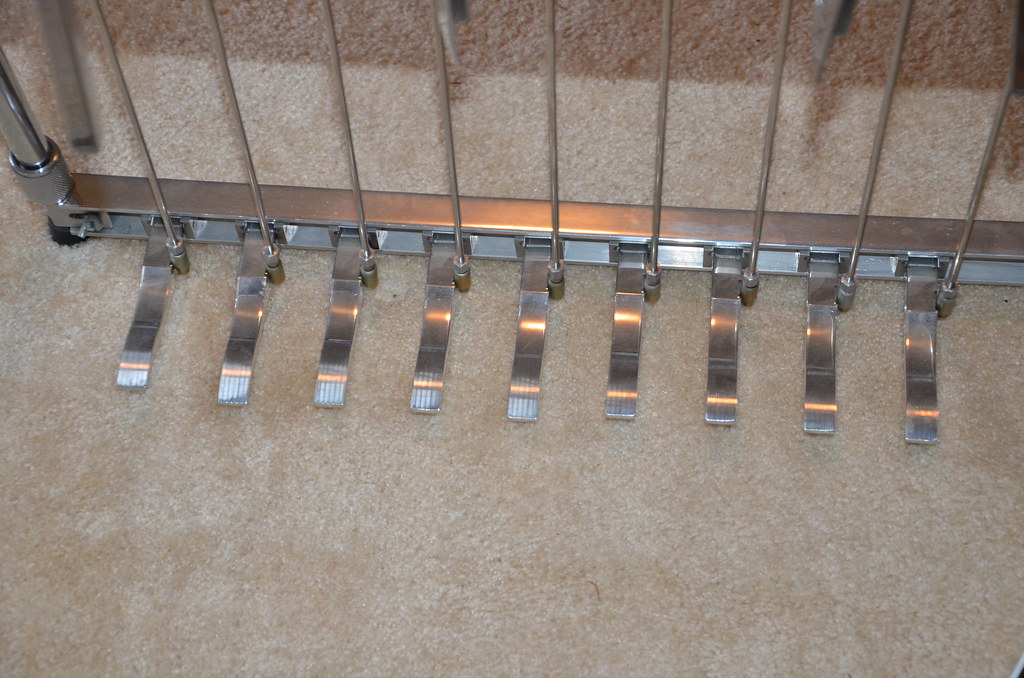 |
| Pedals |
Pushing the left knee lever left to engage and release the lever and it goes back to its original position. There are 2 or three levers for the left knee. They are called LKL, LKR, and LKV for Left Kick Left, Left Kick Right, and Left Kick Vertical. The left and right knee levers are some times called F for LKL and D for LKR. I am unsure what the vertical lever is called. As a side note, I am now questioning the value of the vertical lever as I can achieve the same thing by half stopping my A pedal. For me to use the vertical lever, I need to lift my feet off the pedals to reach the vertical lever and I am not fond of that. On the Day setup the left and right levers are reversed. Regardless of setup chosen, the A, B, and C pedals are used for the E9 neck. Sometimes a player will add a fourth pedal to use with E9. The furtherest right 2 pedals are used with the C6 neck. The remaining pedals can be customized as the player desires. There are usually two levers for the right knee and RKL is sometimes called G and RKR is sometimes called X. Both levers affect both E9 and C6 necks.
The most common tunings on the pedal steel guitar is E9 and C6. E9 is for the Nashville sound and C6 is for Western Swing.
A common copedant might look like this:
E9
String Pitch A B C LKL LKV LKR RKL RKR
1 F# G#
2 D# E D
3 G# A
4 E F# F D#
5 B C# C# A#
6 G# A F#
7 F#
8 E F D#
9 D C#
10 B C# A#
C6
String Pitch P4 P5 P6 P7 P8 LKL LKR RKL RKR
1 G G#
2 E F
3 C D B C#
4 A B B G# A#
5 G F#
6 E D#
7 C C#
8 A B
9 F F# E
10 C D A
At this point, one might wonder why such complexity is necessary. To answer this we must look to the ancestor of the pedal steel guitar. The console guitar was two, three and sometimes four necks, 8 strings on each neck with a different tuning for each neck. There were no pedals or levers. Players of these guitars would slant the tone bar forward or backward to achieve the unique sound of the steel guitar. The pedals and levers do the same thing as slanting the bar. As an example, on the E9 neck a pedal steel player with the tone bar at the 3rd fret pick strings 5 and 6 with the A and B pedals down. Whereas a straight steel player would forward slant the bar so the tone bar and the 5th string intersect at the 5th fret and the 6th string and tone bar intersecting at the 4th fret.
 |
| Me and My Steel! |
With the advent of the pedal steel guitar you can now use both methods! Using our example, with both pedals and bar slanting you can raise the 5th string two steps instead of just one step. How and when you choose to do this is your art.
The next thing to consider is that the E9 has chromatic strings available that are not available on the C6 neck. Likewise the bass strings on the C6 produce the booming sound heard in Western swing and country. These strings are not available on the E9 tuning. These two necks are related by four frets. The 3rd fret on the E9 neck is a G. On the C6 neck G is at the 7th fret. It is possible to switch between necks during a song. Straight steel players switched between necks. See Buddy Merrill play the song South on the Lawrence Welk show with his four neck Fender guitar.
One final word (for now) on copedants. While there are some basic configurations, most experienced players have custom copedants and may add pedals and levers. In my opinion, these custom configurations are driven by player style and genre of music.
In my next post I will discuss my opinion to learning the pedal steel guitar.
No comments:
Post a Comment